The home-built Bundesmarine’s destroyers
Between the first, rebuilt and modernized Zerstörer class (1958) -Fletcher type- and the first missile destroyers of the Lütjens class in 1965, also US-sourced as former Charles F. Adams class, the Bundesmarine obtained its first tailored, home-built destroyers: The Type 101 Hamburg class.
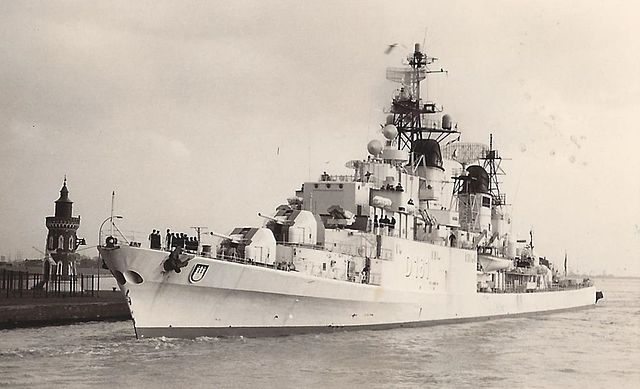
Hamburg (D181) as built
They were originally designed as standard gun-armed destroyers, but became missile destroyers when one of their turret was sacrificed for a set of the brand new MM38 Exocet block 1 during their first major upgrade in 1976-79. The latter allowed them to be kept in service for three decades, and half the cold war, until 1990-94. They were the first and last home-built destroyers for the Bundesmarine. Frigates only followed, yet reaching up the capabilities of destroyers in the 1980s. They were not a success either, design-wise, as built by an inexperienced yard, H. C. Stülcken Sohn in Hamburg. At the time, Blohm & Voss and other famous yards that did had experience with warships were all busy constructing civilian vessels. For most of their career, they were based in Wilhelmshaven (Jade, North sea), making the 2. Zerstörergeschwader (second destroyer squadron).

HS rendition of the Hamburg class
Indeed, the design carried out the same shortcomings of ww2 Kriegsmarine destroyers, they were top-heavy and had in consequences, bad sea-keeping capabilities, because of the low freeboard and flush deck. In 1994, after 30 years of service, they were replaced by the Brandenburg class frigates (F123), which certainly were much improved in all directions, and heavier, longer, and larger, and better armed, showing the leap in technology and scaling.
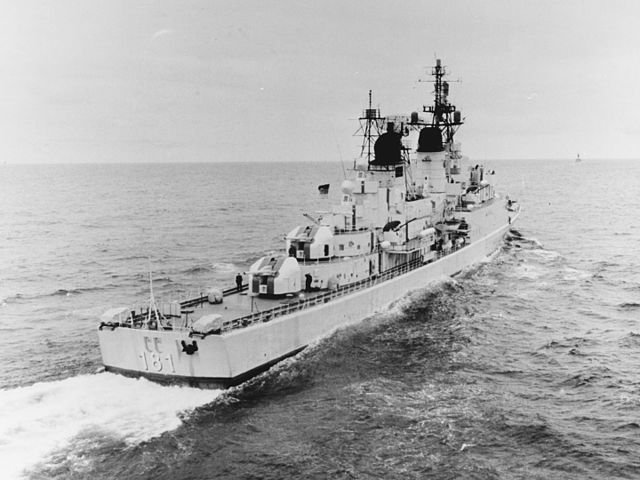
Stern view of Hamburg underway in 1969
Design Development
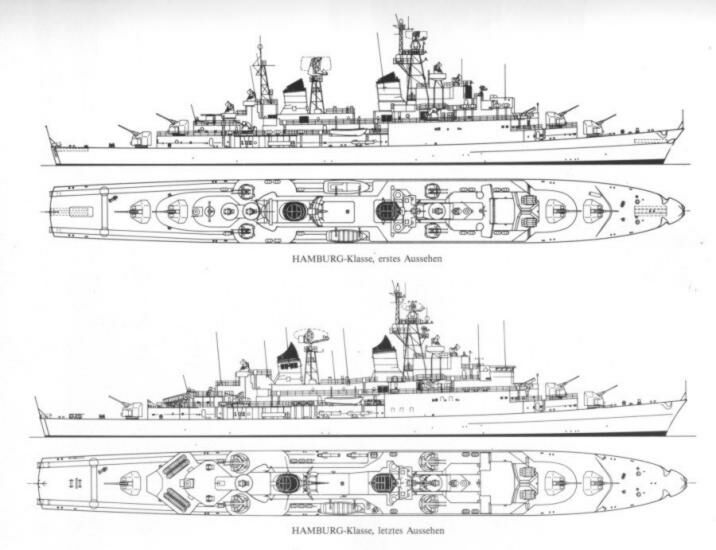
Blueprint of the Hamburg class
The modernized version below had the bow and stern TTs removed, the bridge closed, the ‘C’ aft turret replaced with four MM38 missiles, and the E-measuring beam removed. A chaff rocket launcher was also installed. The ships kept this general appearance until discarded in the 1990s.
To start with specifications, and yard’s capabilities (Stülcken), engineers designed a 3340 tons displacement destroyer, to be on the same technological development level as the Köln (Cologne) Class frigates. During the seventies, they became largest units in the German Navy and backbone of the naval north sea forces, used for convoy duties, anti-ship combat and coastal bombardment, still relying heavily on artillery. But they were not strictly “conventional” in the sense their artillery was dual-purpose and very fast.
The crew at the time was intensive, as automation was limited: 268 men in all, comprising 19 officers.
They originally carried four DCN 100 mm/55 Mod 1954 dual-purpose guns fore and aft in superfiring pairs, four twin Bofors 40 mm/70, and four 533 mm single torpedo tubes, unusually placed in three fixed forward in the bow and one at the stern, and two Bofors 375 mm 4-barrelled trainable anti-ship mortars installed at the upper platform forward, plus two depth charge thrower and minelaying facilities. This was a fairly well-rounded package able to give them good characteristics against all types of targets. However, if artillery was still potent in 1960, their general conception was dated.
Design
General conception
The general design rested on a flush-deck hull, with prow’s wavebreakers like on British cruisers. The prow was thought to be high enough to fend off the north sea bad weather, but the ship as built and modified was overloaded, and pitched heavily in heavy weather, compromising its speed and accuracy as a gun platform, a problem unknown for missile destroyers. This flush-deck hull was partly based on the Köln class frigates, and went back to late WW2 torpedo boats designs. The overall ratio was 1:10, as the hull was 133.7 m (438 ft 8 in) in length overall, by 13.4 m (44 ft 0 in) for the beam and a Draft of 4.8 m (15 ft 9 in). Above this relatively good ratio to achieve the required speed and well studied hydrodynamic lines, the deck level shows the hull was also very beefy at both ends, making a rectangle with a rounded nose and slightly decreased beam aft, down to the squared stern. This configuration made it for maximal room in order to procure housing for all the onboard weapons systems and sensors while still be roomy enough for the crew.
It was compounded by a tall and also beefy superstructure, comprising, from the prow to the stern, the short anchors/capstan section, the two large 100 mm forward turrets with a superfiring one, and its platform was extended both sides to install the two forward 324 mm ASWRLs. A large superstructure extended to both sides of the hull, on two decks level followed, and the forward two twin Bofors mounted abreast. In between was built the open bridge, and a communication room behind, with the two fire control radars for the forward 100 mm turrets, then a first main lattice mast carrying the main navigation sensors. Behind was built the first funnel, followed by the main air surveillance radar, also on a lattice mast, the second funnel, single 324 mm TTs at deck level on either sides, and the quarterhouse, with a superstructure supporting the aft lattice mast (third one) and two superfiring fire control radars, with the two aft twin Bofors mounted abreast, followed by the aft 100 mm main turrets. This made for a busy, crowded superstructure, and engineers should have anticipated a somewhat excessive roll right from the start.
Powerplant
One of the requirements was a high speed and for this they received fitted a high pressure superheated steam propulsion powerplant. This was a trusted and proven propulsion is use since the beginning of the century and in that case, engineers fitted two Wahodag geared steam turbines fed by four boilers from the same manufacturer. They were rated for 68,000 to 72,000 shp, which on paper could provide the contract speed of 34 knots. Yet range was still good, with 9,600 km at 13 knots and 1,475 km at 34 knots (3,400 nautical miles at 18 knots). In sea trials they reached 35 knots (65 km/h) and even 37 knots (69 km/h) for D182, which was a requirements for conventional destroyers at that time but no longer relevant when missile appeared.
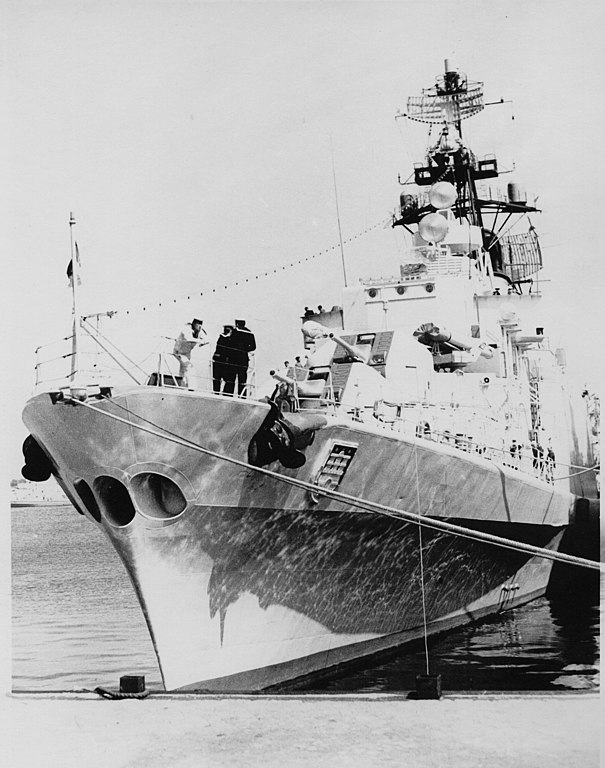
Hamburg’s bow
Armament
DNC 100 mm naval gun
These were French designed guns dated from 1958, and the staple of dual purpose artillery on cold war French vessels of all sizes and tonnage. Outside Germany, which used it on several ships, it was also exported to Belgium, Portugal, Turkey, Brazil, Saudi Arabia, Taiwan and Bulgaria. Gun design started in 1953, by STCAN in Paris, under engineer Tonnelé. He created a triple-purpose weapon, able of AA medium-range defense, antiship and coastal fire support. Semi automatic in a tailored singe mount turret on modèle 53 and modèle 64 it became fully automatic on the modèle 68
and its last evolution was the modèle 100 TR. On the Hamburg class these were the 1st gen M1953. Two crewmen operated the turret: A left gunner, with a joystick to point the gun, its optic ranging and aiming instruments behind a plexiglas viewbay, and an observer seated at the back and monitoring operations in accordance to the ship’s fire direction. Due to the gun’s weight and size, it was placed on the deck and sensible to corrosion, and therefore made water-tight with rubber joints with a muzzle sealed by a rubber tampion. This 100mm/55 (4 inches) was capable of 60 rounds per minute, at 870 m/s, an effective firing range of 17,000 m (elevation 40°), 6,000 m ceiling and 12,000 m against surface targets.
It was probably upgraded to the M1968 after the 1976 refit, like the Köln class frigates.
Secondary AA
The twin Bofors 40 mm was in reality manufactured by Breda under licence. It was 70 caliber. Likely the Mark IX version, which had a Mark VII mount modified to electrical power. The Type 64 by Breda was manufactured under the name DARDO (now under Oto Melara). It was later modernized as the Type 106, Type 107, Type 564 and Type 520 which all saw service on the Marina Militare. The rate of fire is around 220 rpm. It was upgraded in the 1970s to the Type 106 or 107 which had a better RPM, faster traverse and elevation and refined optics.
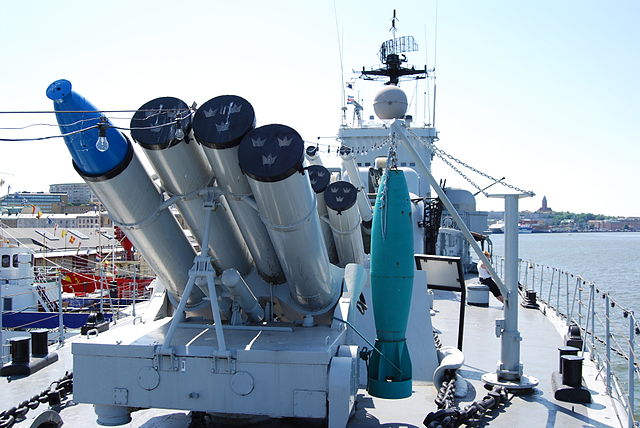
ASW armament
-Quad Bofors 375 mm anti-submarine rocket launchers: Also used in British, French, Dutch, Swedish and Japanese destroyers of the cold war, two such mounts were placed abreast the second main turret on a superfiring position. They fired at 3,625 m (11,893 ft) a heavy rocker with High explosive warhead. This system was considered obsolete in the 1970s and replaced by triple 324 mm TTs with acoustic torpedoes.
In addition the Hamburg class destroyers carried two depth charge ramps and 10 depth charges plus two throwers.
Torpedo armament
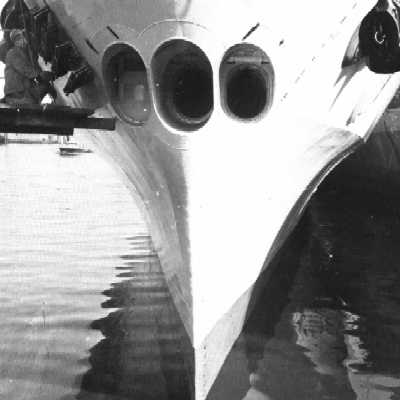
One of of the most striking characteristics of the Hamburg-class (Type 101) where its five fixed torpedo tubes, 3 in the bow and 2 in the stern. Over the years the bow and stern torpedo tubes were removed.
Certainly the most original part of the design, these destroyers carried three fixed tubes in the bow and two in the stern (After the 1970s refit, four single on the broadside). This configuration has not been seen since 1890s battleships, cruisers and torpedo-cruisers. In WW1 and WW2, conventional torpedo tubes banks were placed on the broadside for cruisers, and centerline for destroyers. It was still the norm for early cold war destroyers, However this solution was impossible in the case of Hamburg, which superstructure is already jam-packed. Therefore, as requirements stated four TTs for antiship combat were needed, engineers found this solution was the only one suitable, either than single broadside tubes with limited traverse. The “fixed bank” at least allowed the ship to be steered towards the target before firing a torpedo volley. Personal note: I don’t think any other cold war destroyer used this solution. They were considered obsolete and retired in the 1970s refit but four single ones were kept on the broadside, with limited traverse. The Hamburg class were also equipped with railings running all the way from the forward main superstructure to the stern, able to carry 90 naval mines Mk 17.
Sensors
These ships were equipped with Dutch electronics: A main KH 14/9 navigation radar, DA-08 air surveillance radar, LW-04 radar, SGR-103 and M45 radars, plus four HSA fire-control radars and a Sonar 1BV2. After modernization, one turret was deleted and so was the superfiring aft HSA FCs. The ships were also given two chaff-launchers with 20 barrels each.
The 1975 refit as missile destroyers
So in 1975, the ships were modified to leave their conventional status and embrace the missile age. Four Aerospatiale MM 38 Exocet anti-ship missile launchers, arranged in two twin canisters, were fitted on the only place available, in place of the third 100 mm turret. In place of the Breda-Bofors AA mounts, four twin modernized Breda 40 mm/70 AA were placed (Type 101/106) and the fixed TTs removed. They were replaced by single short anti-ship/anti-submarine torpedo tubes placed on the broadside at deck level. The operations center was completely modernised, and its radar antenna and bridge replaced. The anti-aircraft armament was still still weak by modern standards without a proper SAM. The Exocet MM38 was the first generation, produced from 1975. It measured 4.69 m with a diameter of 350 mm, a launch Weight of 655 kg, a single warhead conventional payload, 165 kg HE fragmentation or semi-armor piercing. It was propelled by Solid fuelled rocket, with a range 40 km, greatly extending the ship’s capabilities. It is not known if these missiles were replaced by the MM39 or 40 before the Hamburg class destroyers were retired.
Active service
The 2nd destroyer squadron was a creation directly linked to the Hamburg class destroyers: The 1st Sqn. was comprising units of the Zerstörer class, and the first destroyer took its service on April 1st, 1965, in Wilhelmshaven. On April 22nd, she was officially commissioned after inspection by the commander of the destroyer flotilla, Captain Mutius at the naval arsenal. First squadron commander was Captain Dehnert. In his inaugural address, in addition to the traditional ties to the home port of Wilhelmshaven he encouraged the crew as to be part of this unit.
The 2nd destroyer squadron was formed, as they were commissioned, of the four class 101 destroyers: The “Hamburg” (D181) in March 23, 1964, “Schleswig-Holstein” (D182) commissioned in October 12, 1964, the “Bayern” (D183) Commissioned in July 6th, 1965 and “Hessen” (D184) on June 10th, 1968. Construction costs was 105 million on average, up to 134 million DM for Hessen which had to be rebuilt above its engines, extracted and modified, delaying her entry into service by three years.
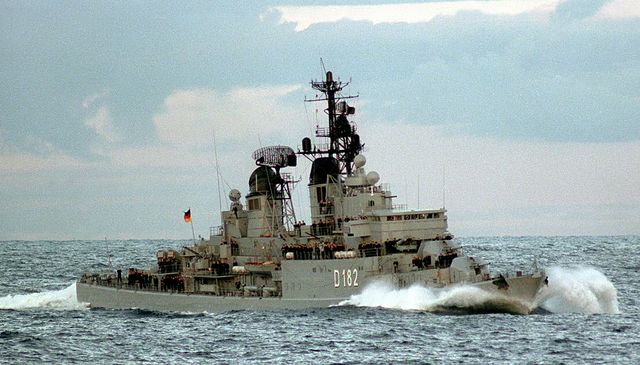
The Hamburg class destroyers were the first designed by German shipbuilders after World War II and had a special significance at the time. The Stülken shipyard in Hamburg designed vessels intended for the protection of merchant ship convoys and both the artillery and sensors illustrates this. Outside its range of weaponry against other ships, aviation and submarines, plus mines, The latest innovations in NBC protection at the time had been implemented. The entire ship was given the so-called “citadel” using a slight positive pressure system to vent off all possible chemical compounds. On October 13th, 1977 the first ship of the 101 klasse to be upgraded was the destroyer “Bayern”. The sacrifice the “C” 100 mm turret was worth the addition of four new MM-38 (EXOCET) sea missiles. The latter flew in the subsonic range and as sea-skimmers, close to the surface, increasing their speed close to the objective. They brought an anti-ship range of around 40 km around the destroyer. After this upgrade, the class was renamed 101 A. From 1978, they received also a fully enclosed bridge. The decommissioning of the first ship of the clas was the destroyer “Hessen” on March 29, 1990. “Bayern” followed on December 16, 1993, “Hamburg” on February 24, 1993 and “Schleswig-Holstein” on December 15, 1994. They had been all replaced by the larger and way more efficient Brandenburg class frigates.
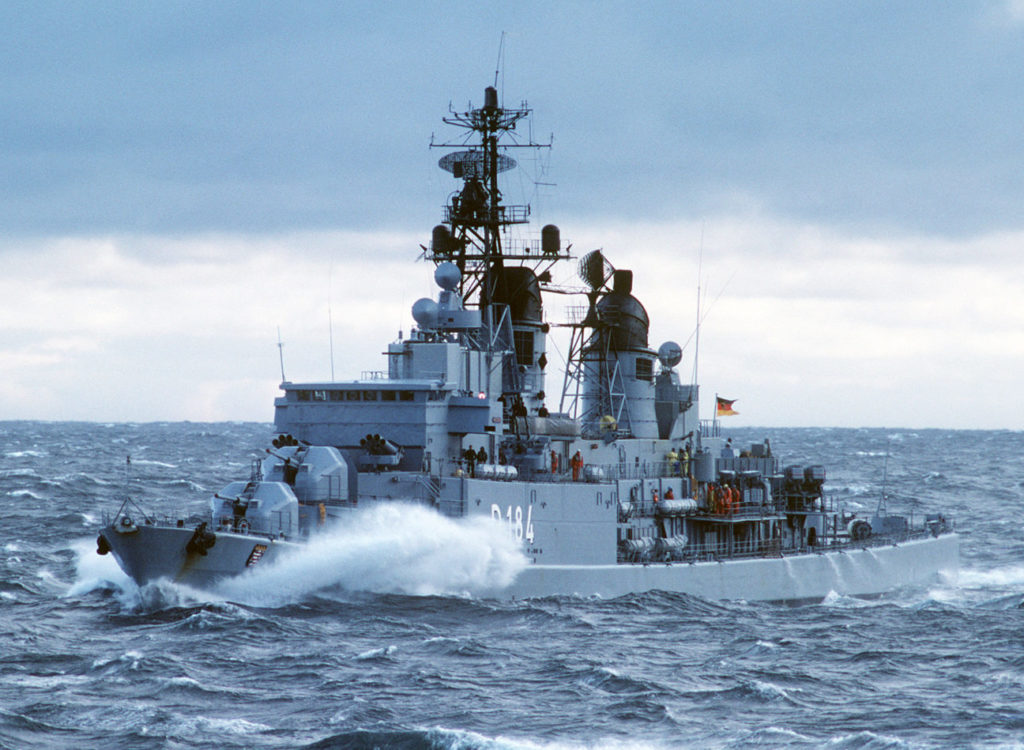
 Hamburg
Hamburg
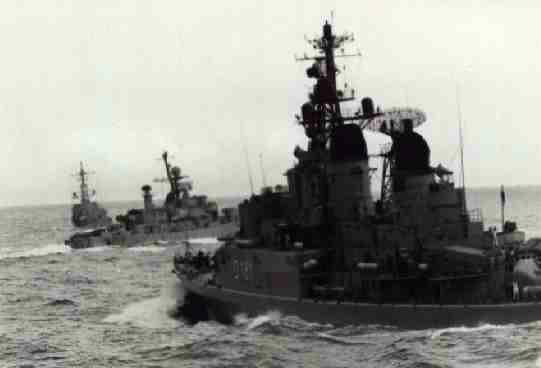
Hamburg was initially subordinated to the 1st destroyer squadron in Kiel, as the squadron was sill buuilding around newly commissionned ships. When the 2nd destroyer squadron was a last constituted on April 1, 1965 in Wilhelmshaven, Hamburg was affected to it. Still, the unit was waiting for the Bayern and Hessen to reach its full complement. Hamburg was assigned the Hull number D 181 and radio call sign DBZK when entering service. By December 1, 1981, its radio call sign was changed to DRAA. In 1975-1976 she was modernized to the class 101A standard. She received, among other things, antiship missiles and larger, enclosed bridge, plus all FCS and radars, sonar, upgraded. During the Cold War the ship performed training missions in the Baltic but also often participated in large NATO formations and execizes. In 1984, she served as flagship for the first German SNFL formation (NATO-Einsatzverband Atlantik).
Only shortly before her end of service did she took part in an active military operation: The blockade of Yugoslavia, as part of Operation Sharp Guard between 1992 and 1993 in the Adriatic. On February 20, 1994, Hamburg was decommissioned. She was mothballed and by 1998 she was sold to Navales via Vebeg in Spain, to be broken up there. Her name went to the second frigate of the 124/Saxony class, on August 16, 2002.
 Schleswig-Holstein
Schleswig-Holstein

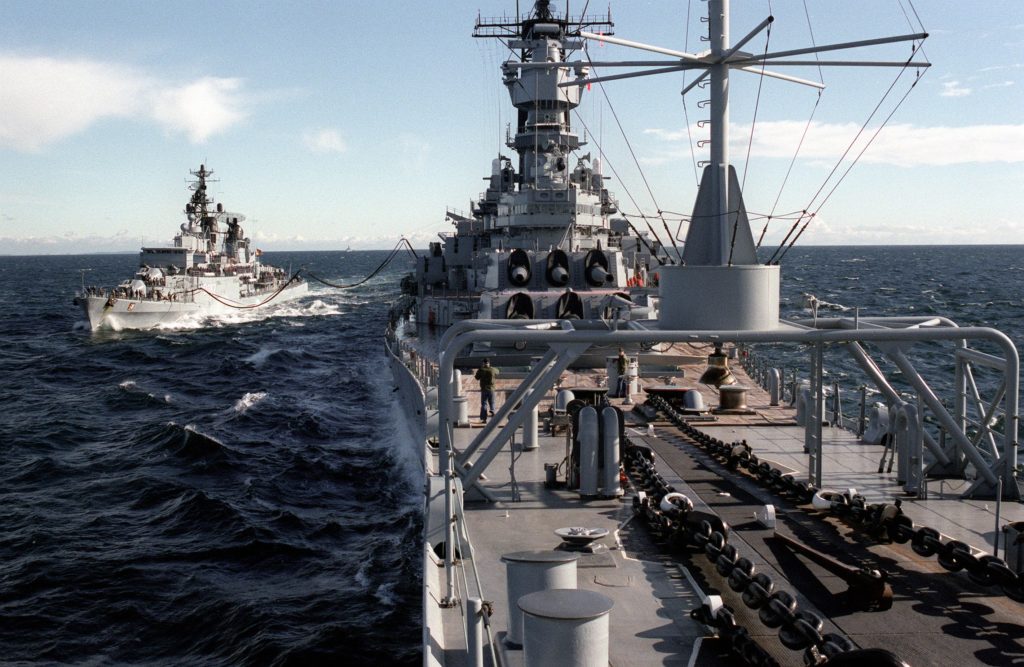
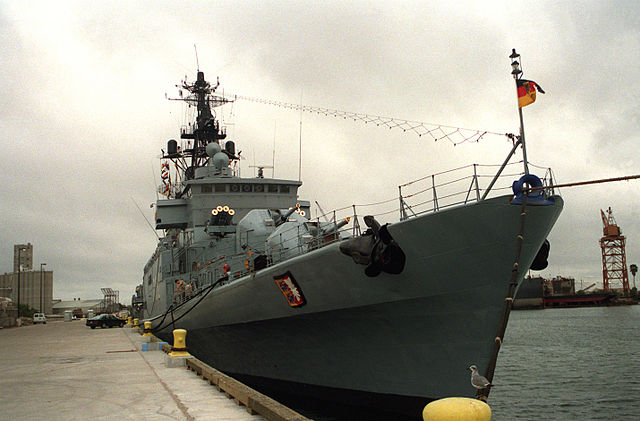
Schleswig-Holstein was laid down as the destroyer “ZB” at the H. C. Stülcken Sohn shipyard in Hamburg, on August 20, 1959, launched exactly one year later and named after this “Lander”, also given to a battleship: Indeed she had the “Sophie-X” name, after her attributed radio call name “SX”, in reference to the WW1 era SMS Schleswig-Holstein (1903-1945). The latter fired the first cannon shot of WW2 in Poland.
After fitting out in Wilhelmshaven she started her shipyard trials, and entered service on October 12, 1964 with the Bundesmarine. She was the second ship of the class 101, and together with her sister ships Hamburg formed the 2nd destroyer squadron in Wilhelmshaven. Later, the unit will gained the remaining Bayern and Hessen. From 1976 to 1979 she was modernized, and after a service without much events, she was decommissioned on December 15, 1994 in the Naval Arsenal in Wilhelmshaven. She was by then the last ship of her class and was sold for BU to a Belgian company.
The traditional name Schleswig-Holstein was given to the second frigate of class 123 (Brandenburg class) on November 24, 1994.
 Bayern
Bayern
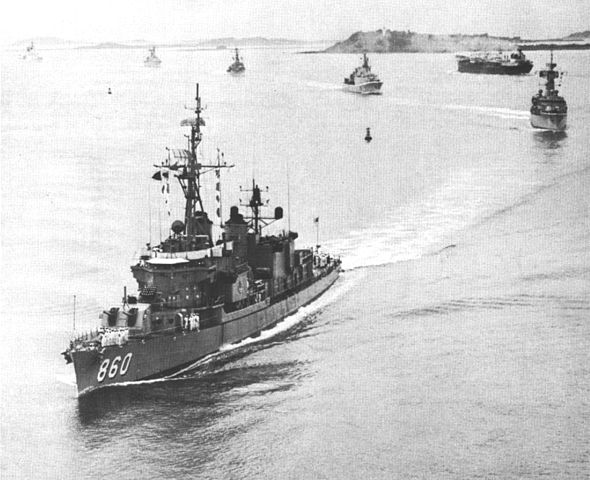
STANAVFORLANT ships entering Boston harbour in 1969
The Bayern was the third launched, on August 14, 1962, in the class 101. Shipyard order name was destroyer 55. She entered service on July 6, 1965, affected to the 2nd destroyer squadron in Wilhelmshaven. Like the other 101 class, she was named after a Lander (Federal state). Her name was previously carried by the lead-ship SMS Bayern of the last WW1-era class battleship, armed with 38 cm guns. Like her sister-ships, she entered the drydock for a complete modernization and partial rebuilt, between november 29, 1976 and November 26, 1977. As converted as a guided missile destroyer (DDG) she was now under the 101A class nomenclature. On May 8, 1980 during an exercise, Bayern collided with the fuel transporter Spessart (of the 1st Supply Squadron). Her bow was compressed inwards as far as the breakwater. As this exercize took place in the Mediterranean, she stayed in Toulon for an emergency repair and received a provisionl bow in order to get back home. In 1990 Bayern was the first German warship to visit the Israeli port of Haifa, as part of the NAVOCFORMED AAG 109/90. In 1992 she was also the first German ship to be involved in an active operation, the Adriatic embargo preventing armament to reach the belligerents during the yugoslav war (Operation Maritime Monitor). Bayern was decommissioned on December 16, 1993, and sold to Denmark on April 25, 1995 to the company VEBEG.
 Hessen
Hessen
Hessen was launched on May 4, 1963 as the fourth and last of the 101 class destroyer. Her shipyard name was Destroyer 55. In October 17-23, 1966, she made her shipyard trials in the North Sea and Skagerrak. She made her official trials and acceptance run on December 11, 1966. It revealed problems with the drive system. Couplings between the turbines and gearboxes had to be improved, and so the Bundesmarine procurement office refused her. Initially launched at the Naval Arsenal of Wilhelmshaven, she returned in drydock where her deficiencies were eliminated. So it was not until October 8, 1968, more than ten years after being planned, that Hessen entered service. She was immediately sent to the 2nd destroyer squadron in Wilhelmshaven. Also named after a lander, she perpetuated a name in the Imperial Navy, a pre-dreadnought of the Braunschweig class, SMS Hessen. Her career went on without incident until on December 2, 1971, as there was an explosion fire in an electrical plant, which saw two of crew members died. In 1974 a “red cell” was discovered on board, causing great concern in the ship’s command. These crewmen had distributed the illegal newspaper “Hessentorpedo”. Hessen’s conversion to the 101A standard started on November 1, 1974. Conversion was completed and final acceptance trial was performed on February 22, 1976, and she was recommissioned. There was no other notable even in her career. Hessen was was decommissioned on March 29, 1990, sold on September 8, 1991 via the company Vebeg to Eckart in Hamburg to be broken up, but was scrapped in Portugal.

Hamburg underway during a NATO exercize, in 1980

Schleswig-Holstein at sea in the 1980s, side view
Detailed Specifications (Techn. data 101A)
Displacement: 4,050 tonnes standard, 4,692 t. fully loaded
Length overall: 134 m (438 ft 8 in)
Beam: 13.4 m (44 ft 0 in)
Draft: 5.2 m (15 ft 9 in)
Powerplant: 4 Wahodag boilers, 2 steam turbines, 68-72,000 shp
Top Speed: 35 knots (65 km/h) – 37 knots (69 km/h) trials D182
Fuel supply: 809 cbm diesel fuel (F75)
Cruising range: 3400 nautical miles (6,300 km) at 18 knots (33 km/h)
Crew: 284 men
Armament: 3×1 100 mm turrets L/55, Model 53 (4 in)
-4×2 40 mm L70 mounts Mod 64 MDL Breda (2 in)
-4×1 MM38 anti-ship missiles in aft canisters
-2×4 Bofors 375 mm ASWRL fwd
-Four ASW/AS 533 mm broadside, fixed torpedo tubes
-2 depth charges racks sten (10 total)
-Two 20-barrel 105 mm Breda chaff rocket launchers
-Minelaying fittings for 90 mines Mk 17
Electronic equipment:
-3 HSA (Hollandse Signaal Apperaten) fire control systems
-3 HSA tactical radar systems (LW, ZW, DA antennas)
-Sonar
-WLR-1C EW
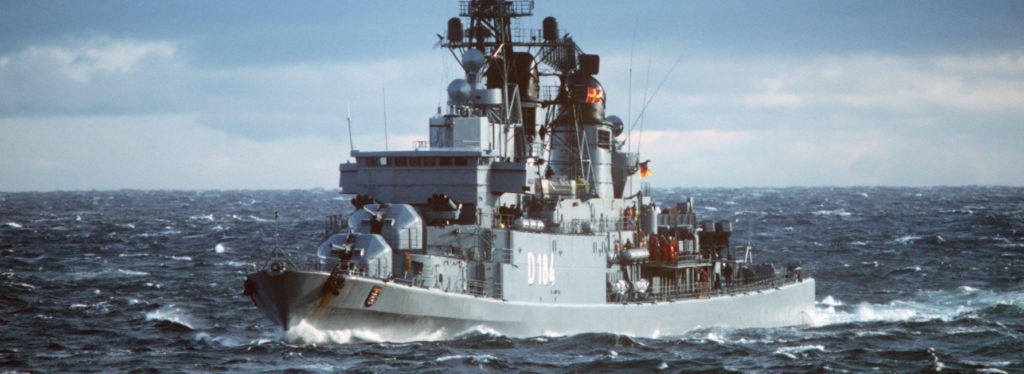
Read More/Src
(Pdf) Comparison between the Bundesmarine and GDR navy
https://www.globalsecurity.org/military/world/europe/type-101.htm
http://hamburg-klasse.20m.com/
https://de.wikipedia.org/wiki/Klasse_101/101A
https://www.z-bayern.de/
https://www.zerstoerer-hessen.de/
http://www.d-182.de/
https://www.zerstoerer-hamburg.de/
https://en.wikipedia.org/wiki/Hamburg-class_destroyer
Model Kits:
Peddinghaus 1/700 Hamburg class
Admiralty Model Works (all four) 1/700


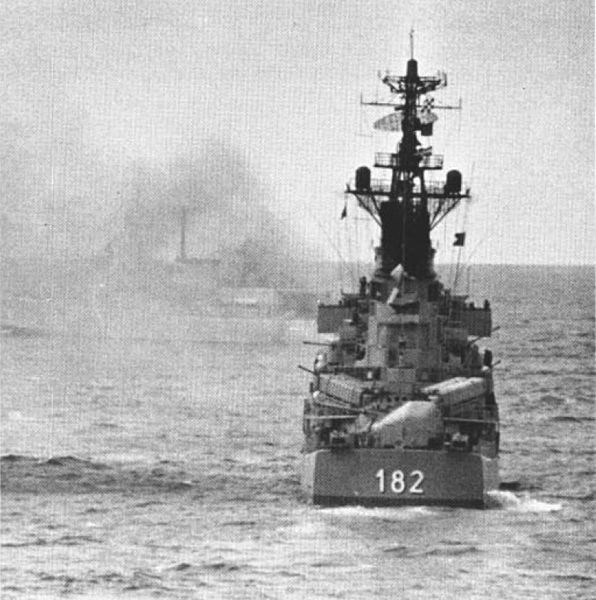
 Latest Facebook Entry -
Latest Facebook Entry -  X(Tweeter) Naval Encyclopedia's deck archive
X(Tweeter) Naval Encyclopedia's deck archive Instagram (@navalencyc)
Instagram (@navalencyc)





 French Navy
French Navy Royal Navy
Royal Navy Russian Navy
Russian Navy Armada Espanola
Armada Espanola Austrian Navy
Austrian Navy K.u.K. Kriegsmarine
K.u.K. Kriegsmarine Dansk Marine
Dansk Marine Nautiko Hellenon
Nautiko Hellenon Koninklije Marine 1870
Koninklije Marine 1870 Marinha do Brasil
Marinha do Brasil Osmanlı Donanması
Osmanlı Donanması Marina Do Peru
Marina Do Peru Marinha do Portugal
Marinha do Portugal Regia Marina 1870
Regia Marina 1870 Nihhon Kaigun 1870
Nihhon Kaigun 1870 Preußische Marine 1870
Preußische Marine 1870 Russkiy Flot 1870
Russkiy Flot 1870 Svenska marinen
Svenska marinen Søværnet
Søværnet Union Navy
Union Navy Confederate Navy
Confederate Navy Armada de Argentina
Armada de Argentina Imperial Chinese Navy
Imperial Chinese Navy Marinha do Portugal
Marinha do Portugal Mexico
Mexico Kaiserliche Marine
Kaiserliche Marine 1898 US Navy
1898 US Navy Sovietskiy Flot
Sovietskiy Flot Royal Canadian Navy
Royal Canadian Navy Royal Australian Navy
Royal Australian Navy RNZN Fleet
RNZN Fleet Chinese Navy 1937
Chinese Navy 1937 Kriegsmarine
Kriegsmarine Chilean Navy
Chilean Navy Danish Navy
Danish Navy Finnish Navy
Finnish Navy Hellenic Navy
Hellenic Navy Polish Navy
Polish Navy Romanian Navy
Romanian Navy Turkish Navy
Turkish Navy Royal Yugoslav Navy
Royal Yugoslav Navy Royal Thai Navy
Royal Thai Navy Minor Navies
Minor Navies Albania
Albania Austria
Austria Belgium
Belgium Columbia
Columbia Costa Rica
Costa Rica Cuba
Cuba Czechoslovakia
Czechoslovakia Dominican Republic
Dominican Republic Haiti
Haiti Hungary
Hungary Honduras
Honduras Estonia
Estonia Iceland
Iceland Eire
Eire Equador
Equador Iran
Iran Iraq
Iraq Latvia
Latvia Liberia
Liberia Lithuania
Lithuania Mandchukuo
Mandchukuo Morocco
Morocco Nicaragua
Nicaragua Persia
Persia San Salvador
San Salvador Sarawak
Sarawak Uruguay
Uruguay Venezuela
Venezuela Zanzibar
Zanzibar Warsaw Pact Navies
Warsaw Pact Navies Bulgaria
Bulgaria Hungary
Hungary

 Bundesmarine
Bundesmarine Dutch Navy
Dutch Navy Hellenic Navy
Hellenic Navy Marina Militare
Marina Militare Yugoslav Navy
Yugoslav Navy Chinese Navy
Chinese Navy Indian Navy
Indian Navy Indonesian Navy
Indonesian Navy JMSDF
JMSDF North Korean Navy
North Korean Navy Pakistani Navy
Pakistani Navy Philippines Navy
Philippines Navy ROKN
ROKN Rep. of Singapore Navy
Rep. of Singapore Navy Taiwanese Navy
Taiwanese Navy IDF Navy
IDF Navy Saudi Navy
Saudi Navy Royal New Zealand Navy
Royal New Zealand Navy Egyptian Navy
Egyptian Navy South African Navy
South African Navy






























 Ukrainian Navy
Ukrainian Navy dbodesign
dbodesign